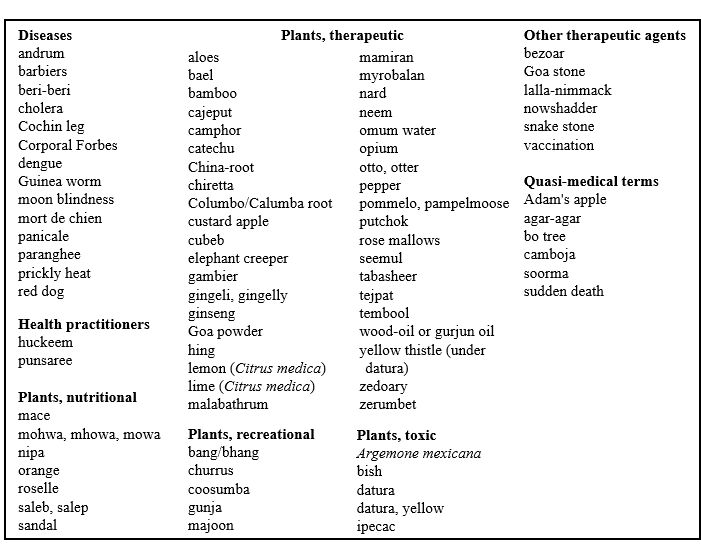Last week I discussed Hobson–Jobson: A Glossary of Colloquial Anglo-Indian Words and Phrases, and of Kindred Terms, Etymological, Historical, Geographical and Discursive.
Although many have called Hobson-Jobson a dictionary, that is not the best description. Its authors, Henry Yule and A C Burnell, called it a glossary, a term that is defined in the Oxford English Dictionary (OED) as “a list with explanations of abstruse, antiquated, dialectal, or technical terms; a partial dictionary”. That well describes Hobson-Jobson.
Many articles have been written about Hobson–Jobson, but I have seen no discussion of its medical content. Burnell died in 1882 and Yule in 1889. William Crooke published a second edition in 1903, in which I have found 84 items of medical interest (Box 1). Crooke indicated his additions by enclosing them in square brackets. We can therefore tell that all but one of these terms was also included in the first edition, the exception being “rose mallows”, which Crooke defined as “A semifluid resin, the product of the Liquidambar altingia, which grows in Tenasserim; also known as Liquid Storax, and used for various medicinal purposes.”

Nearly 60 of the 84 items are plants of one sort or another, mostly used for therapeutic purposes, some regarded as having nutritional value, a few listed as sources of what we nowadays call recreational drugs, and a few because of their toxic properties. The main authority cited is Hanbury and Flückiger’s Pharmacographia (1874); the Pharmacopoeia of India and Schröder’s Pharmacopoeia Medico-chymica (1654) are also quoted.
To take an example at random, Argemone mexicana is mentioned twice, once under its own heading and once in an entry “datura, yellow, and yellow thistle”, described as “Bombay names for the Argemone mexicana, fico del inferno of Spaniards.” It causes a condition known as epidemic dropsy, seen mostly in India, but also reported elsewhere. It is caused by ingestion of mustard oil or ghee adulterated with oil from the seeds of Argemone mexicana, the Mexican poppy or thistle, which contains a toxin called sanguinarine, so called because it was first identified in Sanguinaria canadensis, the blood-root. Epidemic dropsy presents with gastrointestinal symptoms a week or so before the onset of pitting oedema of the legs, fever, and darkening of the skin, often with local erythema and tenderness. Perianal itching is common, and myocarditis and congestive cardiac failure can occur, as can anaemia, hepatomegaly, pneumonia, ascites, glaucoma, alopecia, and sarcoid-like skin changes.
In The BMJ in 1892, beri-beri was referred to as “an acute epidemic general dropsy”, at a time when its cause was not known. However, in January 1893, the journal reported a description, given at the Epidemiological Society, of “epidemic dropsy” seen in Assam and elsewhere, whose clinical features, and particularly the absence of neuropathy, distinguished it from beri-beri. Its cause was unknown. Later that year, the journal reviewed a book by Kenneth McLeod, titled Epidemic Dropsy, in which epidemic dropsy as we recognize it today was described as having occurred in Calcutta in 1877–80. However, it was not until 1939 that the dropsy was connected to Argemone mexicana by research done at the All-India Institute of Hygiene and Public Health in Calcutta. Again The BMJ reported the finding. Earlier accounts had reported the use of Argemone oil as a useful remedy, especially in skin diseases.
Of entries relating to other diseases, half are associated with infections: cholera, also called “Corporal Forbes” and mort de chien (by folk etymology from its original Portuguese name, mordexim), Cochin leg and panicale (elephantiasis), dengue, and Guinea-worm infection.
The terms of medical interest whose etymology they discuss, the authors derive from many languages, including Arabic, Chinese, Greek, Hindi, Malay, Malayalam, Persian, Sanskrit, Singhalese, Spanish, Syriac, and Tamil, reflecting the huge diversity of the entries.
Those who would suppress all discussion about British colonialism, or destroy any evidence of it, might want to add Hobson–Jobson to their list of undesirable objects. The fact that Salman Rushdie has described it as “the legendary dictionary of British India” may reinforce their view. But although it can hardly be regarded as a reliable dictionary, and certainly not “the definitive glossary of British India”, as one edition brands it, it reflects an important part of British history and, if nothing else, is highly entertaining.
Jeffrey Aronson is a clinical pharmacologist, working in the Centre for Evidence Based Medicine in Oxford’s Nuffield Department of Primary Care Health Sciences. He is also president emeritus of the British Pharmacological Society.
Competing interests: none declared.

